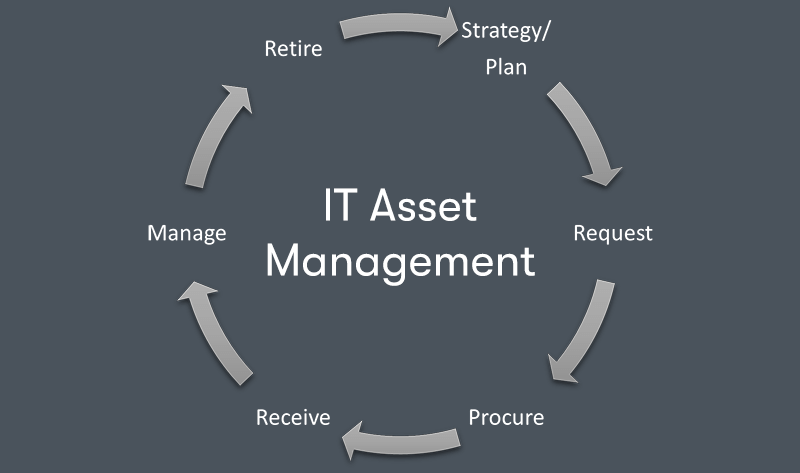IT Asset Management
IT Asset Management (ITAM) is the process of overseeing and optimising an organisation's IT assets throughout their lifecycle. IT assets refer to any hardware, software, or digital resources used to support business operations. These assets can range from physical devices like computers, servers, and networking equipment to intangible assets such as software licenses, digital documents, and virtual machines.
What is ITAM?
ITAM stands for Information Technology Asset Management. ITAM is a crucial discipline that helps organisations efficiently manage their IT resources, ensure compliance, reduce costs, and enhance overall IT governance and security. In simple terms it’s about understanding what your assets are, where they are, who’s using them and what are they using them for.
What Is The Objectives Of IT Asset Management?
IT Asset Management contributes significantly to an organisation's efficiency, security, cost-effectiveness, and overall IT governance. It helps businesses make informed decisions, reduce risks, and maximise the value of their IT investments. Here are some objectives of IT asset management:
Inventory Management:
Objective: Maintain a comprehensive and accurate inventory of all IT assets within the organisation.
Importance: Having a complete inventory helps in understanding the organisation's IT infrastructure, making it easier to manage assets, plan for upgrades, and track their lifecycle.
Procurement and Acquisition:
Objective: Ensure efficient and cost-effective acquisition of new IT assets.
Importance: Proper procurement practices help in obtaining the right assets at the right price, considering factors such as vendor reputation, warranty, compatibility, and long-term support.
License Management:
Objective: Monitor and manage software licenses to ensure compliance with vendor agreements and optimise software usage.
Importance: License management helps organisations avoid legal issues related to software piracy, unauthorised usage, and potential financial penalties.
Asset Tracking and Monitoring:
Objective: Monitor the status, performance, and usage of IT assets to ensure optimal functionality and identify potential issues.
Importance: Regular monitoring helps in proactive maintenance, reduces downtime, and identifies underutilised or overburdened assets.
Cost Control and Optimisation:
Objective: Analyse IT asset costs and usage patterns to identify opportunities for cost savings and optimise asset allocation.
Importance: Cost control and optimisation lead to more efficient resource utilisation, reduced wastage, and better financial management.
Risk Management and Security:
Objective: Identify and mitigate potential risks associated with IT assets, such as security vulnerabilities or data breaches.
Importance: Effective risk management safeguards sensitive data, protects the organisation's reputation, and ensures compliance with data protection regulations.
Disposal and Retirement:
Objective: Properly dispose of or retire outdated or non-functional assets in an environmentally responsible and compliant manner.
Importance: Secure disposal of assets helps prevent data breaches, environmental harm, and legal liabilities associated with improper disposal.
Contract Management:
Objective: Manage contracts and service level agreements (SLAs) with vendors and service providers.
Importance: Effective contract management ensures that vendors meet their commitments and helps in negotiating favourable terms and conditions.
Performance Optimisation:
Objective: Optimise the performance of IT assets to meet the organisation's requirements and goals.
Importance: Ensuring that IT assets perform at their best enhances overall productivity and user satisfaction.
IT Governance and Decision Making:
Objective: Provide data-driven insights to support IT governance and strategic decision-making.
Importance: ITAM data aids in formulating IT strategies, planning investments, and aligning IT with the organisation's overall objectives.
Why Is IT Asset Management Important?
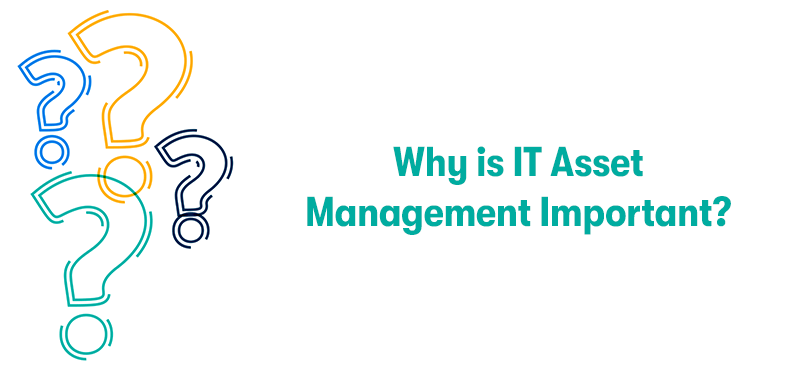
IT Asset Management (ITAM) is crucial for several reasons, as it plays a fundamental role in effectively managing an organisation's IT resources and infrastructure. Here are some key reasons why IT Asset Management is important:
Cost Control and Optimisation
IT assets represent a significant investment for organisations. ITAM helps track asset usage, identify underutilised resources, and optimise asset allocation, leading to cost savings and more efficient spending.
License Compliance
Effective ITAM and specifically software asset management ensures that the organisation complies with software licensing agreements. Non-compliance can lead to legal issues, financial penalties, and damage to the organisation's reputation.
Security and Risk Management
ITAM helps identify and mitigate security risks associated with IT assets, reducing the likelihood of data breaches, cyberattacks, and other security incidents.
Improved Productivity
A well-managed IT asset inventory reduces downtime caused by hardware or software failures, leading to improved productivity and uninterrupted business operations.
Efficient Procurement
ITAM facilitates better decision-making when acquiring new IT assets, considering factors such as compatibility, vendor reputation, and long-term support.
IT Governance
ITAM provides essential data for IT governance and strategic planning, enabling organisations to align IT resources with business objectives effectively.
Disaster Recovery and Business Continuity
Knowing the location and specifications of IT assets helps in disaster recovery planning and ensuring business continuity during critical situations.
Environmental Responsibility
Proper disposal and recycling of IT assets contribute to environmental sustainability and demonstrate corporate responsibility.
Vendor Management
ITAM data supports effective vendor management, enabling organisations to negotiate better deals and hold vendors accountable for service levels.
Data Security and Privacy
Managing IT assets ensures that data stored on devices is secure and that proper measures are in place to protect sensitive information.
Change Management
Accurate ITAM date assists in managing changes to IT infrastructure, minimising disruptions and ensuring smooth transitions during upgrades or replacements.
IT Service Management (ITSM) Integration
ITAM can be integrated with ITSM processes, streamlining incident management, problem resolution, release management, configuration management, service catalogue management and asset tracking. In fact accurate, complete and up to date asset data support most ITSM practices and processes.
IT Asset Management Process
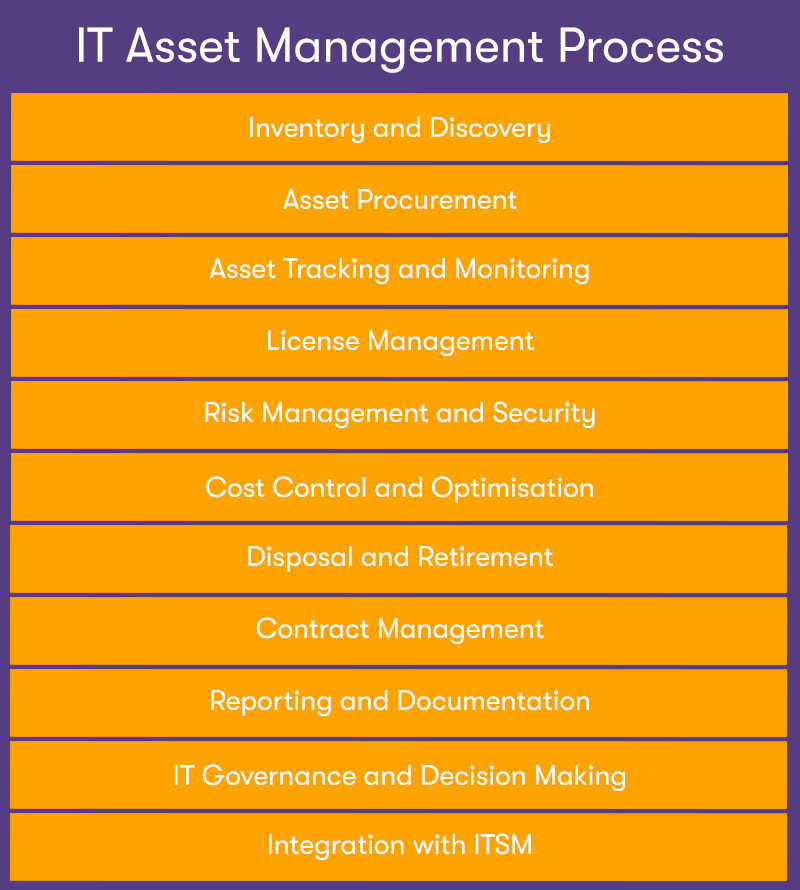
The IT Asset Management process involves a series of interconnected steps that organisations follow to effectively manage their IT assets throughout their lifecycle. While the specific processes may vary depending on the organisation's size and requirements, a typical ITAM process includes the following stages:
Inventory and Discovery:
- Identify and catalogue all IT assets, including hardware, software, licenses, and digital resources.
- Use discovery tools to automatically scan the network and collect asset data.
Asset Procurement:
- Establish standardised procurement procedures for acquiring new IT assets.
- Evaluate vendors, negotiate contracts, and ensure compliance with procurement policies.
Asset Tracking and Monitoring:
- Continuously monitor asset status, performance, and health to identify potential issues.
- Track changes and updates to assets throughout their lifecycle.
License Management:
- Track software licenses, ensuring compliance with licensing agreements.
- Optimise license usage to avoid under-licensing or over-licensing.
Risk Management and Security:
- Identify and mitigate security risks associated with IT assets.
- Implement security measures to protect sensitive data.
Cost Control and Optimisation:
- Analyse IT asset costs to identify areas for cost savings and optimisation.
- Optimise asset allocation to maximise ROI.
Disposal and Retirement:
- Develop end-of-life strategies for outdated or non-functional assets.
- Ensure environmentally responsible and secure disposal or recycling of retired assets.
Contract Management:
- Manage contracts and service level agreements with vendors and service providers.
- Ensure vendors meet their commitments and provide quality service.
Reporting and Documentation:
- Generate reports on IT asset status, costs, and performance.
- Maintain accurate documentation for audits and compliance.
IT Governance and Decision Making:
- Provide data-driven insights to support IT governance and strategic decision-making.
- Align IT strategies with business objectives.
Integration with ITSM:
- Integrate ITAM processes with ITSM for streamlined change management, incident management and problem resolution.
The ITAM process is iterative, requiring continuous monitoring and improvement. Utilising specialised ITAM software and tools can significantly streamline the process, providing organisations with a centralised platform to manage their IT assets efficiently. Through effective ITAM, organisations can optimise resource usage, reduce costs, enhance security, and align their IT operations with business goals.
Types of IT Asset Management
IT Asset Management (ITAM) can be categorised into different types based on the focus and scope of asset management within an organisation. The key types of IT Asset Management are:
Hardware Asset Management (HAM)
This type of ITAM focuses on managing physical IT assets, such as computers, servers, networking equipment, printers, and other hardware devices. It involves tracking their inventory, monitoring performance, and planning for hardware upgrades or replacements.
Software Asset Management (SAM)
SAM deals with the management of software assets, including licenses, applications, and digital resources. It involves tracking software installations, managing license compliance, optimising software usage, and ensuring proper software disposal.
Financial Asset Management
This type of ITAM emphasises managing IT assets from a financial perspective. It involves tracking asset costs, analysing budgets, and making financial decisions related to IT investments.
Contract and Vendor Management
This type of ITAM focuses on managing contracts and relationships with IT vendors and service providers. It includes negotiating contract terms, tracking vendor performance, and ensuring vendors meet their commitments.
Cloud Asset Management
As organisations increasingly adopt cloud-based services, cloud asset management becomes essential. It involves monitoring and managing cloud resources, optimising cloud costs, and ensuring compliance with cloud service agreements.
Mobile Device Management (MDM)
MDM is a specialised type of ITAM that focuses on managing mobile devices, such as smartphones and tablets, used within the organisation. It includes device tracking, security measures, and application management for mobile devices.
Network Asset Management
This type of ITAM is centred around managing networking assets, including routers, switches, firewalls, and other network infrastructure components. It involves monitoring network performance, optimising network resources, and planning for network upgrades.
Endpoint Security Management
This type of ITAM focuses on securing endpoints like laptops, desktops, and mobile devices from security threats. It includes implementing security measures, ensuring patch management, and enforcing security policies.
Data Asset Management
Data asset management involves managing data resources, such as databases, digital documents, and other data repositories. It includes data backup and recovery, data governance, and data retention policies.
Virtualisation Asset Management
In virtualised environments, this type of ITAM deals with managing virtual machines, virtual servers, and other virtual assets. It involves optimising virtual resource usage and tracking virtual asset performance.
Organisations may choose to implement one or more of these types of IT Asset Management, depending on their specific needs, infrastructure, and business goals. A comprehensive ITAM strategy often involves integrating multiple types to ensure efficient management of all IT assets across the organisation.
IT Asset Manager Roles and Responsibilities
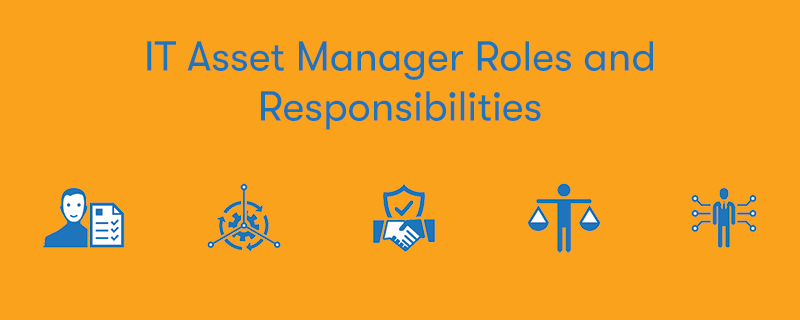
The role of an IT Asset Manager is crucial in ensuring effective management and optimisation of an organisation's IT assets. IT Asset Managers are responsible for various tasks related to the lifecycle of IT assets, from procurement to disposal. Their roles and responsibilities may include, but are not limited to, the following:
Inventory Management
Maintaining a comprehensive and up-to-date inventory of all IT assets, including hardware, software, and digital resources, along with their specifications, locations, and ownership details.
Procurement and Acquisition
Overseeing the acquisition of new IT assets, evaluating vendor options, negotiating contracts, and ensuring compliance with procurement policies.
License Management
Tracking software licenses, ensuring compliance with licensing agreements, managing license renewals, and optimising license usage.
Asset Tracking and Monitoring
Regularly monitoring the status, performance, and health of IT assets to identify potential issues and plan for maintenance or upgrades.
Cost Control and Optimisation
Analysing IT asset costs, identifying areas for cost savings, and optimising asset allocation to achieve the best return on investment.
Risk Management and Security
Assessing and mitigating security risks associated with IT assets, implementing security measures, and ensuring data protection and privacy.
Disposal and Retirement
Managing the proper disposal or retirement of outdated or non-functional assets in an environmentally responsible and compliant manner.
Contract Management
Managing contracts and service level agreements with vendors and service providers, ensuring they meet their commitments.
Vendor Management
Building and maintaining relationships with IT vendors, negotiating terms, and evaluating vendor performance.
Asset Lifecycle Planning
Developing plans for the lifecycle of IT assets, including upgrade schedules, replacements, and end-of-life strategies.
IT Governance Support
Providing data and insights to support IT governance and strategic decision-making within the organisation.
Compliance and Audits
Ensuring compliance with software licensing agreements, data privacy regulations, and assisting with IT asset audits.
Reporting and Documentation
Generating reports on IT asset status, costs, and performance, and maintaining accurate documentation for audit purposes.
Change Management
Coordinating IT asset-related changes, such as software updates, hardware replacements, and technology migrations.
Environmental Responsibility
Ensuring that IT asset disposal and recycling practices align with environmental sustainability goals.
Integration with ITSM
Integrating ITAM processes with IT Service Management (ITSM) to improve incident management and problem resolution.
What Are The Implications of Bad IT Asset Management?
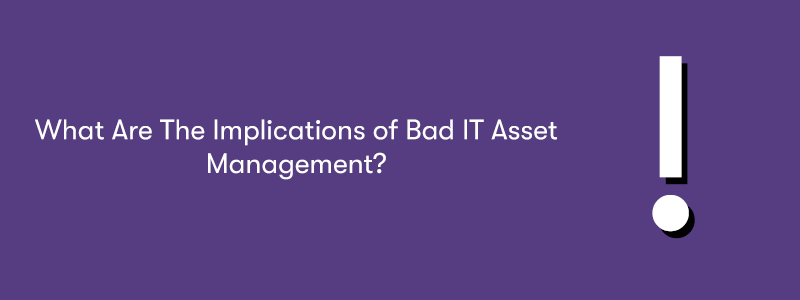
If an organisation lacks good IT Asset Management, it can face several negative consequences that can impact its operations, financial stability, security, and overall efficiency. Here are some potential outcomes of not having a robust IT Asset Management process:
Increased Costs
Without proper ITAM, the organisation may overspend on IT assets, leading to higher procurement costs, unnecessary software licenses, and underutilised hardware.
Non-Compliance and Legal Risks
Inadequate management of software licenses can result in non-compliance with vendor agreements and copyright laws, leading to legal and financial penalties.
Security Vulnerabilities
Poor ITAM can lead to unpatched or outdated software and hardware, leaving the organisation susceptible to security breaches and cyberattacks.
Inefficient Resource Allocation
Lack of visibility into asset usage can result in resources being allocated to departments or projects that don't require them, leading to inefficiencies.
Downtime and Productivity Loss
Without proper monitoring and maintenance, IT assets are more likely to fail, leading to unplanned downtime and reduced productivity.
Disruptions during Audits
Inability to provide accurate and up-to-date asset information during audits can lead to difficulties in demonstrating compliance and may result in negative audit findings.
Inaccurate Financial Reporting
Without a clear view of IT assets, financial reporting can be inaccurate, leading to discrepancies in budgeting and financial planning.
Data Security Breaches
Inadequate ITAM can result in lost or stolen devices containing sensitive data, leading to potential data breaches and loss of customer trust.
Lack of IT Governance
Absence of ITAM can hinder effective IT governance, making it difficult to align IT strategies with business objectives and track technology investments.
Inability to Plan for Upgrades
Without knowledge of asset lifecycles, the organisation may struggle to plan for timely upgrades and replacements, leading to outdated technology.
Environmental Impact
Inadequate disposal practices for retired IT assets can harm the environment and expose the organisation to legal and reputational risks.
Vendor Management Issues
Inefficient ITAM can lead to challenges in managing vendor relationships, resulting in poor service levels, and missed opportunities for cost savings.
Overall, the lack of good IT Asset Management can lead to significant inefficiencies, financial losses, security risks, and compliance issues for the organisation. Having a robust ITAM process is essential for optimising IT resources, ensuring data security, adhering to regulations, and aligning technology with business needs.
Where Can You Learn More?
IT Asset Management (ITAM) Foundation Course
Our IT Asset Management (ITAM) Foundation training course will teach you about the four key ITAM areas and their interaction in relation to contract management, compliance, information security, cost control and IT business value:
- Hardware Asset Management (including Mobile devices)
- Software Asset Management
- Services & Cloud Asset Management
- People and Information Asset Management (including Bring Your Own Device)

Hardware Asset Management Specialist Course
Our hardware asset management course will learn the best practices in Hardware Asset Management, as well as the practicality to understand and accordingly increase the maturity of HAM by a Tier Based Implementation.

Software Asset Management Specialist Course
Our Software Asset Management (SAM) Specialist training course will cover best practices in Software Asset Management, as well as the practicality to understand and accordingly increase the maturity of SWAM by a Tier based implementation.

Final Notes On IT Asset Management
In conclusion, IT Asset Management is a cornerstone of efficient and secure IT operations for organisations. With ITAM, businesses gain better control over their IT resources, enabling cost optimisation, compliance with licensing agreements, and proactive risk management. IT Asset Managers play a vital role in maintaining accurate inventories, ensuring proper procurement, monitoring asset health, and supporting IT governance.
Without effective ITAM, businesses may face increased costs, security vulnerabilities, and legal risks. To thrive in the dynamic digital landscape, organisations must prioritise ITAM, harnessing its power to drive productivity, mitigate risks, and make informed, data-driven decisions for a successful future.


